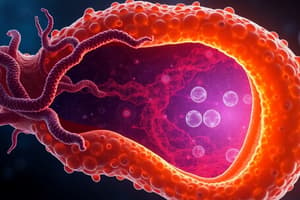Podcast
Questions and Answers
What are SNAREs?
What are SNAREs?
Attachment protein receptors that drive the fusion of two membranes - mediate exocytosis.
What are v-SNAREs and t-SNAREs?
What are v-SNAREs and t-SNAREs?
v-SNAREs are part of the vesicle membrane, and t-SNAREs are part of the target.
Give an example of a v-SNARE and t-SNARE.
Give an example of a v-SNARE and t-SNARE.
v-SNARE = synaptobrevin/VAMP; t-SNARE = syntaxin, SNAP25.
What are the functions of t-SNAREs?
What are the functions of t-SNAREs?
What is the process of vesicle fusion mediated by SNARE complexes?
What is the process of vesicle fusion mediated by SNARE complexes?
What is the role of SNAREs in autophagy?
What is the role of SNAREs in autophagy?
How do SNARE complexes mediate nervous system excitation?
How do SNARE complexes mediate nervous system excitation?
How is the SNARE complex disassembled for recycling?
How is the SNARE complex disassembled for recycling?
What protein inhibits NSF and SNAP proteins, affecting SNARE complex recycling?
What protein inhibits NSF and SNAP proteins, affecting SNARE complex recycling?
Why are SNARE molecules required to drive membrane fusion?
Why are SNARE molecules required to drive membrane fusion?
What are mutations in SNAP complex associated proteins associated with?
What are mutations in SNAP complex associated proteins associated with?
How can the function of SNAREs be targeted for treatment of neurological conditions?
How can the function of SNAREs be targeted for treatment of neurological conditions?
How is botulinum toxin paralysis naturally reversed?
How is botulinum toxin paralysis naturally reversed?
Flashcards are hidden until you start studying
Study Notes
SNARE Proteins Overview
- SNAREs are attachment protein receptors that drive membrane fusion, essential for exocytosis.
- All SNARE proteins share a conserved SNARE motif/domain.
Types of SNAREs
- v-SNAREs are located on vesicle membranes.
- t-SNAREs are situated on target membranes.
Examples of SNAREs
- v-SNARE example: Synaptobrevin (VAMP), localized to synaptic vesicles.
- t-SNARE examples: Syntaxin and SNAP-25, primarily found on neuronal plasma membranes.
- Synaptogamin functions as a calcium sensor.
Functions of t-SNAREs
- Typically associated with nerve terminal membranes.
- SNAP-25 enhances membrane fusion specificity by forming a tight complex that facilitates fusion of synaptic vesicles with plasma membranes.
Vesicle Fusion Process
- Vesicle trafficking involves docking at the target membrane.
- Activation of SNARE proteins occurs post-docking to fuse vesicle and target membranes.
Role of SNAREs in Autophagy
- In macroautophagy, SNAREs are involved in phagophore formation and fusion with lysosomes.
- Autophagosomes degrade cellular components through lysosomal fusion, mediated by SNAREs.
SNARE Complex in Neuronal Activity
- Synaptobrevin is present on vesicles containing neurotransmitters.
- The target brain membrane contains t-SNAREs, specifically syntaxins 1, 2, 3.
- Fusion creates a trans-SNARE complex, leading to neurotransmitter release.
Disassembly of SNARE Complex
- NSF and SNAP proteins disassemble the SNARE complex for recycling.
- ATP hydrolysis provides the energy necessary for disassembly.
Inhibition of SNARE Complex Recycling
- NEN protein inhibits NSF, preventing SNARE complex disassembly and affecting recycling efficiency.
Importance of SNAREs in Membrane Fusion
- SNAREs facilitate rapid vesicle release by being pre-primed in a partly paired state, avoiding extensive rearrangements during fusion.
Mutations in SNARE-Associated Proteins
- VAMP1 mutations are linked to Alzheimer’s disease due to impaired Aβ-containing vesicle fusion.
- Syntaxin11 mutations cause FHL4, affecting T-cell cytotoxic granule secretion and leading to immunodeficiency.
Therapeutic Targeting of SNARE Functions
- Botulinum toxins target SNAREs to inhibit acetylcholine release at motor neurons, resulting in muscle paralysis.
Reversal of Botulinum Toxin Paralysis
- Botulinum toxin leads to SNARE protein cleavage, but natural turnover of SNARE complexes can restore function.
- Botulinum toxin is taken up into vesicles, endocytosed, and cleaves SNARE proteins like SNAP-25, disrupting neurotransmission.
Studying That Suits You
Use AI to generate personalized quizzes and flashcards to suit your learning preferences.



